SpaceX Polaris Dawn astronauts perform historic 1st private spacewalk in orbit (video)
"SpaceX, back at home we have a lot of work to do, but from here it looks like a perfect world."
Polaris Dawn just made history again.
SpaceX's private crew of four astronauts performed the world's first commercial spacewalk while soaring high above Earth on Thursday (Sept. 12) during the third day of a five-day trip to Earth orbit.
"SpaceX, back at home we have a lot of work to do, but from here it looks like a perfect world," Polaris Dawn commander Jared Isaacman, the American billionaire who financed the mission, said as he looked down on Earth while standing mostly outside the Dragon hatch.
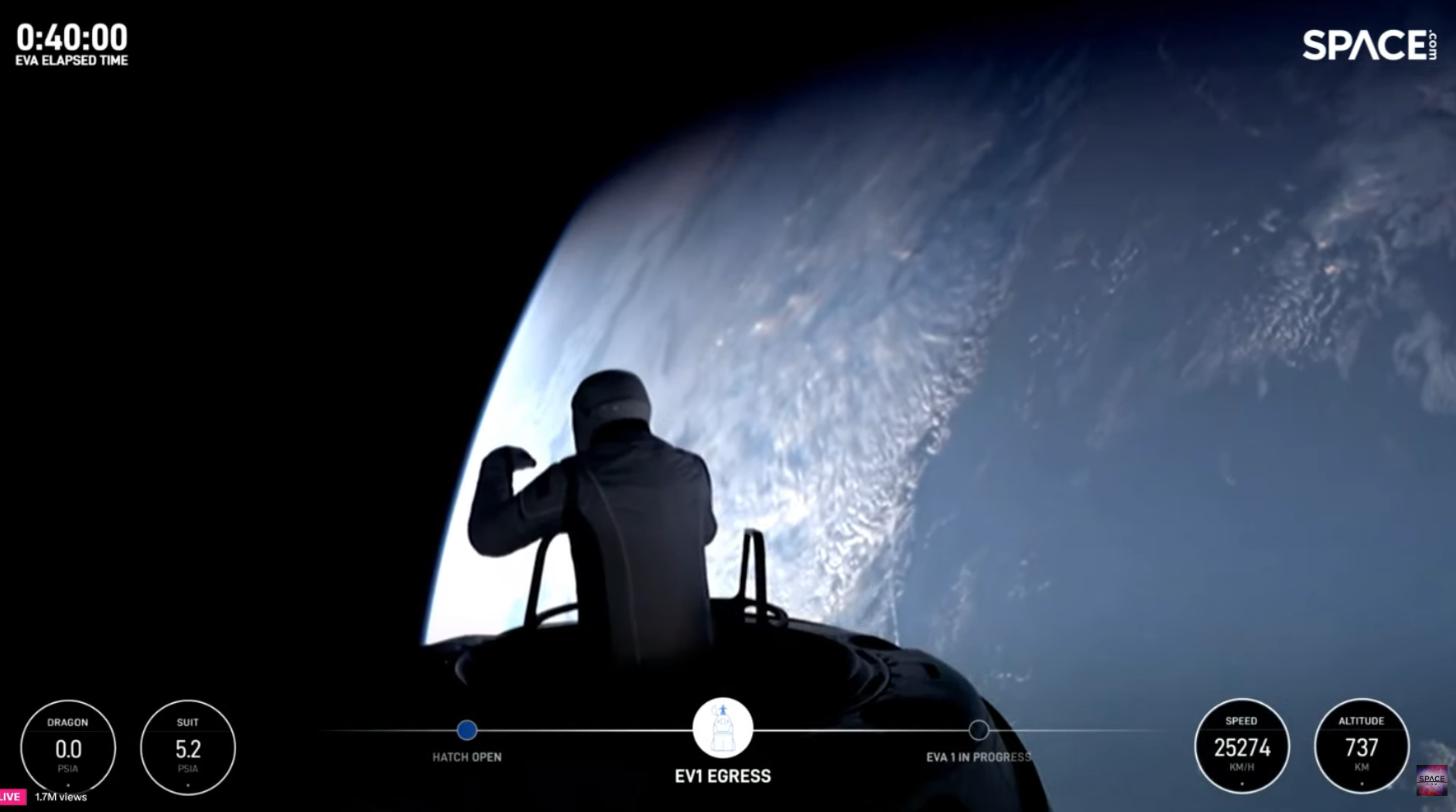
SpaceX launched the four astronauts — Isaacman, pilot Scott "Kidd" Poteet" and mission specialists Sarah Gillis and Anna Menon (both of SpaceX) — into orbit on Tuesday (Sept. 10) atop a Falcon 9 rocket that lifted off from the historic Launch Complex-39A at NASA's Kennedy Space Center. It was the same launch pad that hosted Apollo 11, the first mission to put humans on the moon.
Fifteen hours later, the crew made their first bit of space history when they reached an altitude of 870 miles (1,400.7 kilometers), higher than any other crewed mission since the Apollo program a half-century ago. Another NASA mission, Gemini 11, previously held the altitude record for a crewed spacecraft in Earth's orbit at 853 miles (1,373 km).
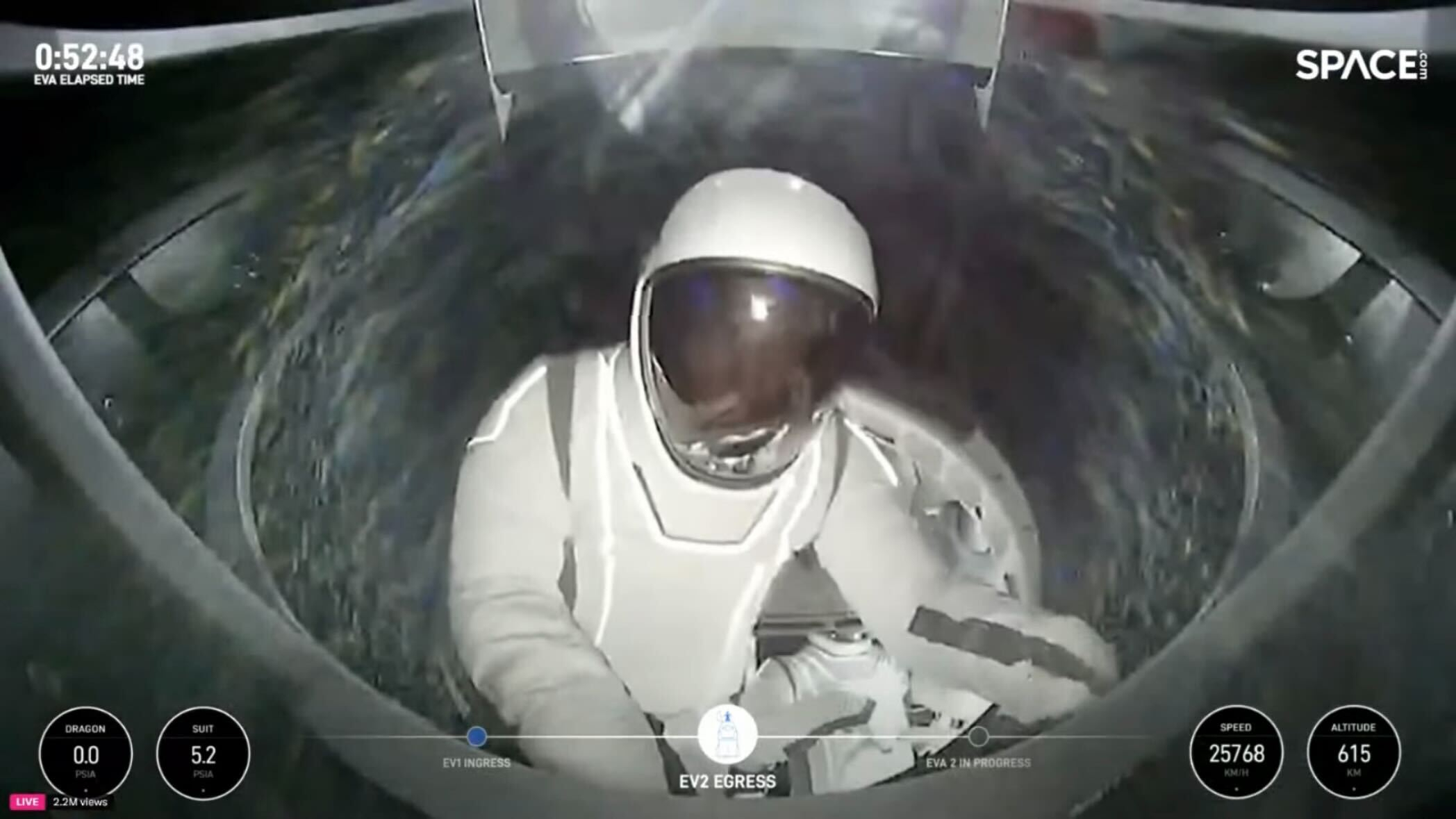
But Polaris Dawn didn't stop there.
After reaching the record-high altitude, the mission's Crew Dragon Resilience spacecraft lowered to 458 miles (737 km) at its highest point. Once there, Resilience was depressurized, and Isaacman and Sarah Gillis exited into the void one at a time, with Isaacman popping out at about 6:48 a.m. EDT (1048 GMT) and Gillis following at 7:04 a.m. EDT (1104 GMT).
Get the Space.com Newsletter
Breaking space news, the latest updates on rocket launches, skywatching events and more!
The spacewalk began at 6:12 a.m. EDT (1012 GMT), nearly four hours later than initially announced, and was expected to last about two hours. During the spacewalk, both Isaacman and Gillis performed a series of spacesuit mobility checks as SpaceX captured stunning live views of the two astronauts standing up, most of their bodies outside the spacecraft.
The Dragon hatch was closed at about 7:14 a.m. EDT (1114 GMT) as SpaceX began repressurizing the spacecraft. According to SpaceX, the entire spacewalk lasted one hour and 46 minutes, from 6:12 a.m. EDT (1012 GMT) to 7:58 EDT (1158 GMT).
"Whew! Smell that? Space," Isaacman said after the hatch was closed and the capsule began its repressurization process. "Nice job for everyone at SpaceX who made it possible."
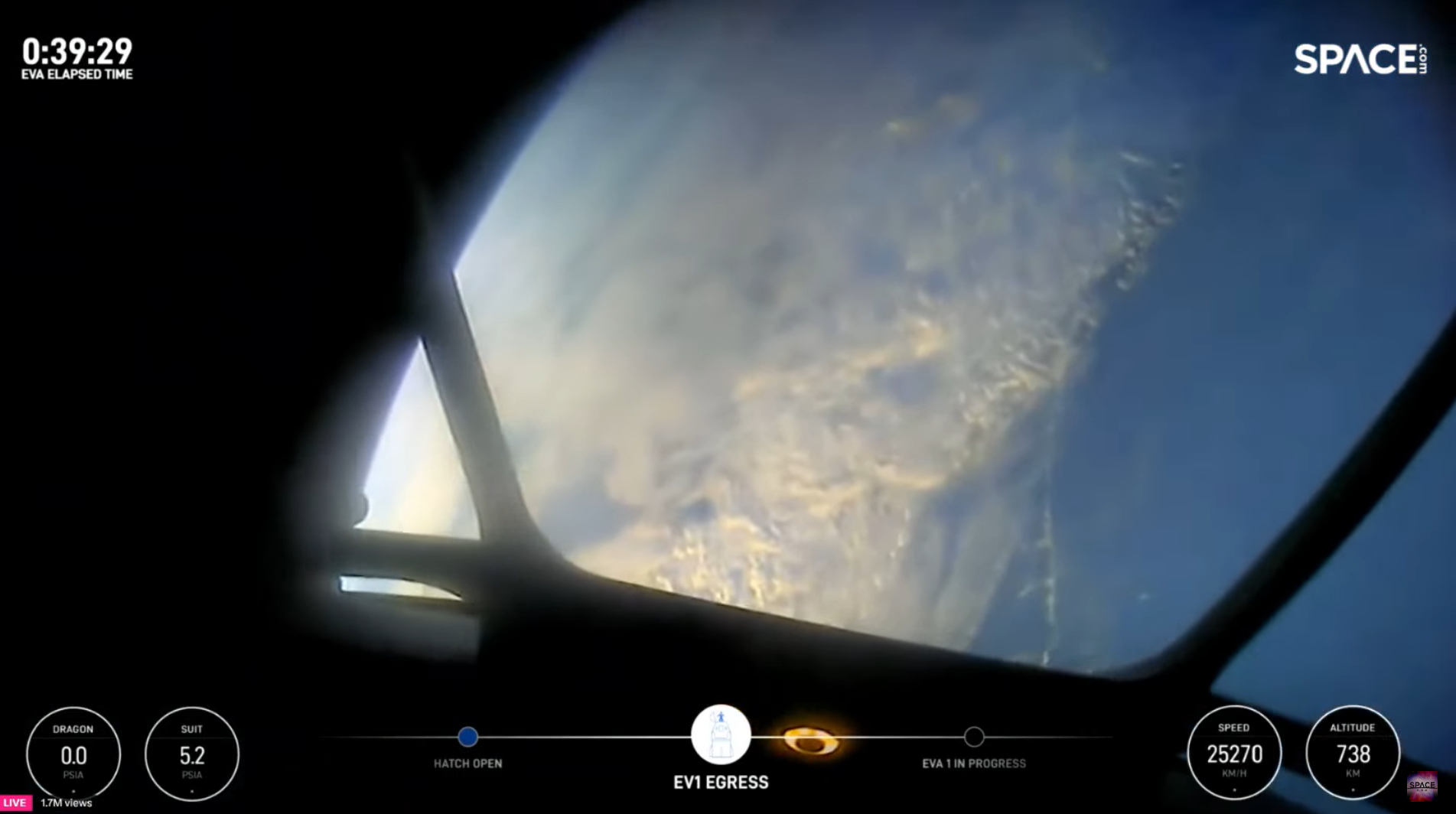
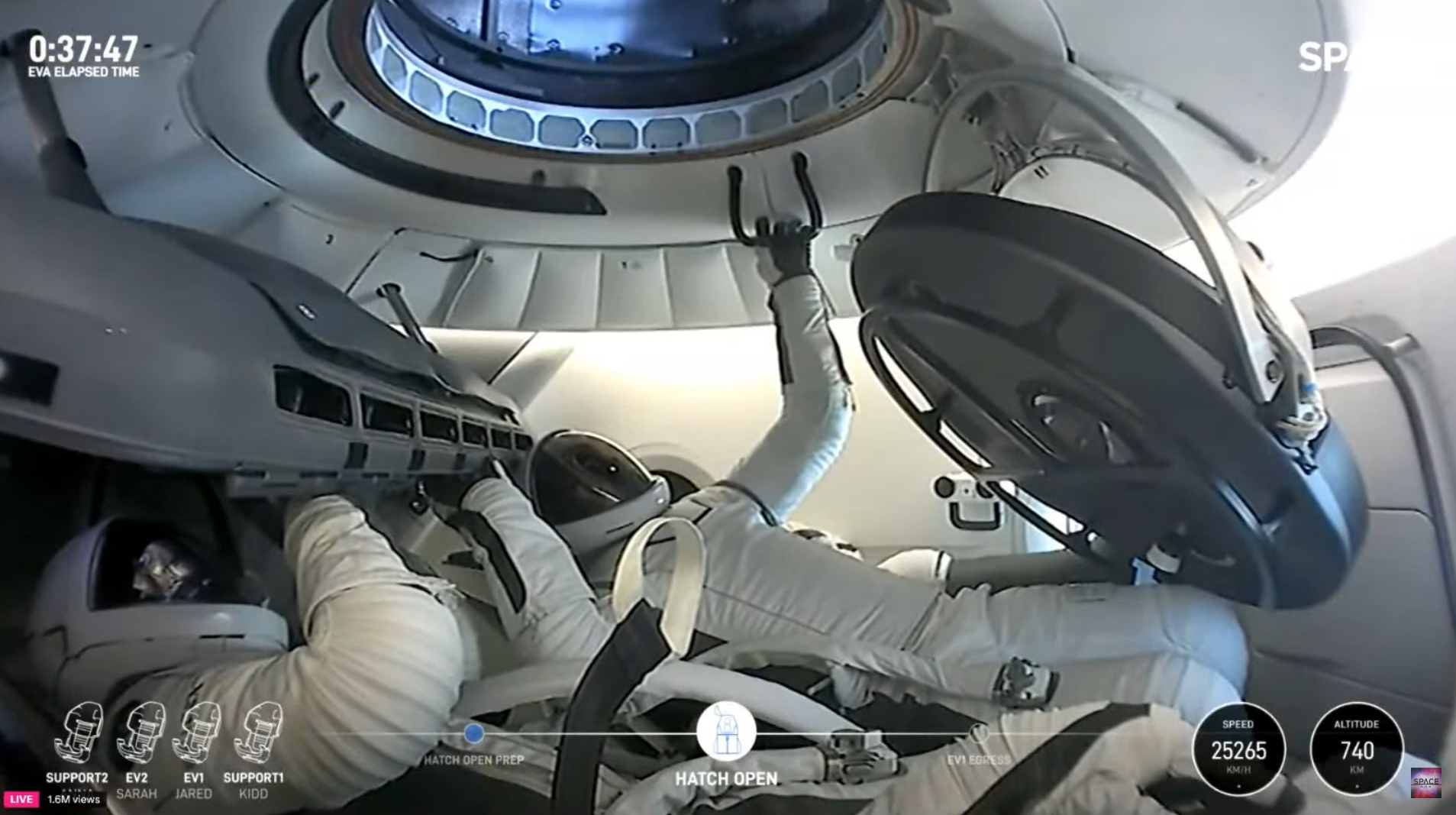
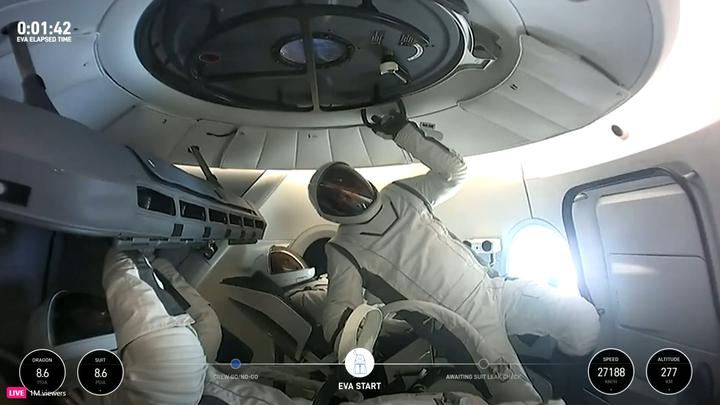
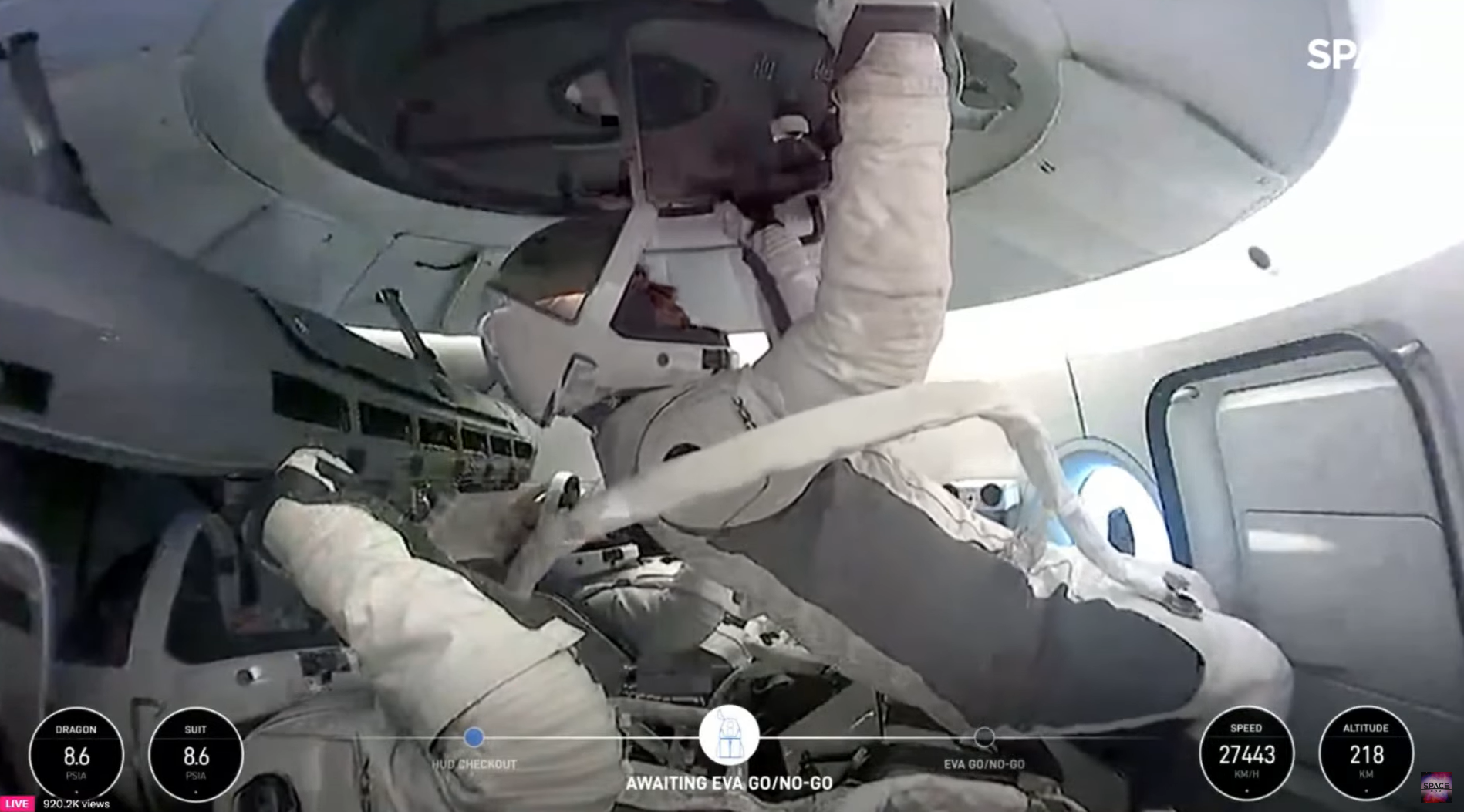
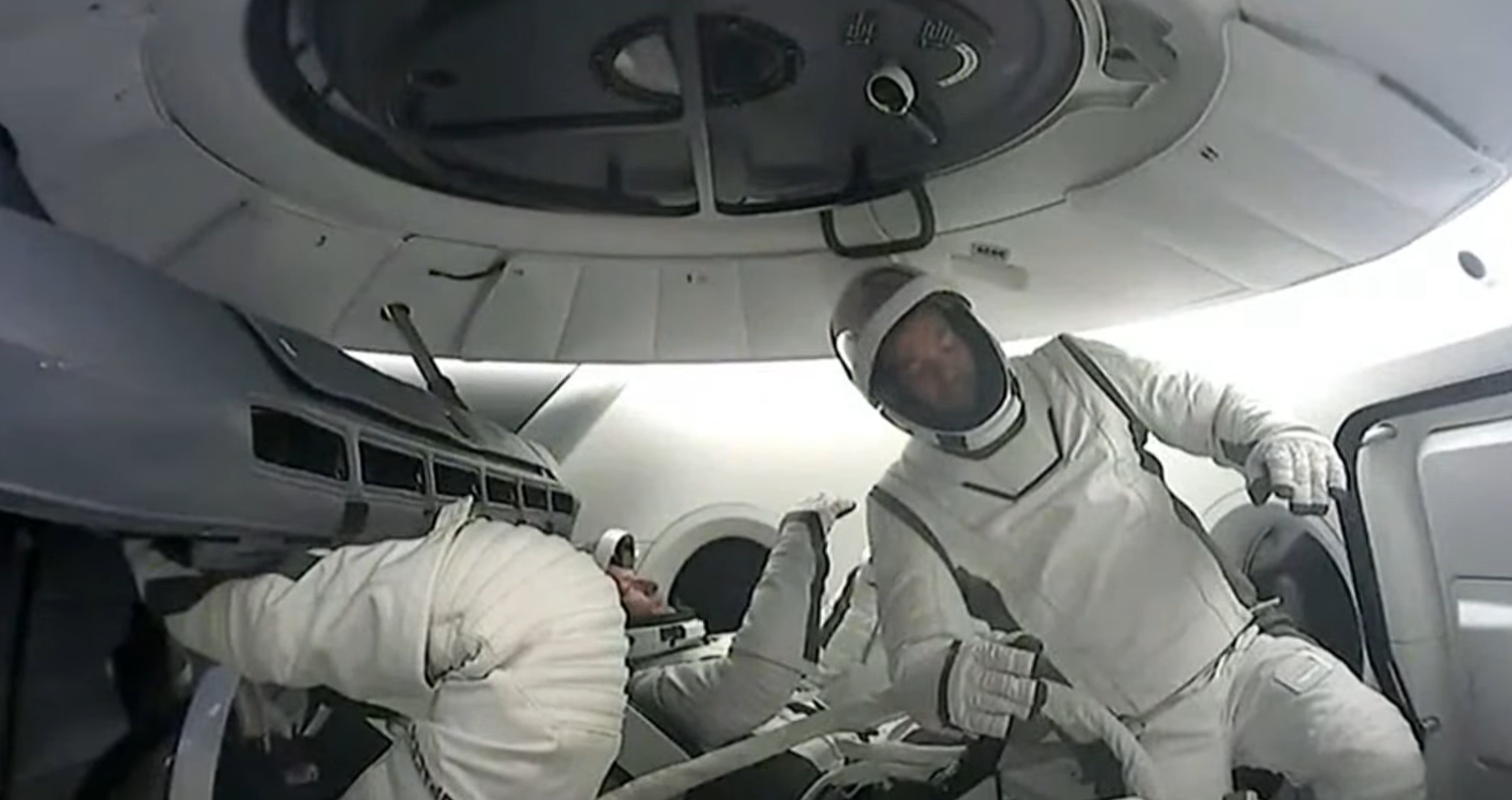
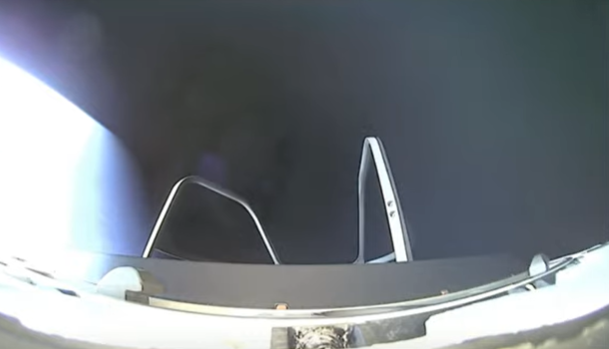
The Polaris Dawn crew consists of Isaacman, who funded and commands the mission; mission specialists Gillis and Menon; and pilot Poteet, a former lieutenant colonel in the U.S. Air Force.
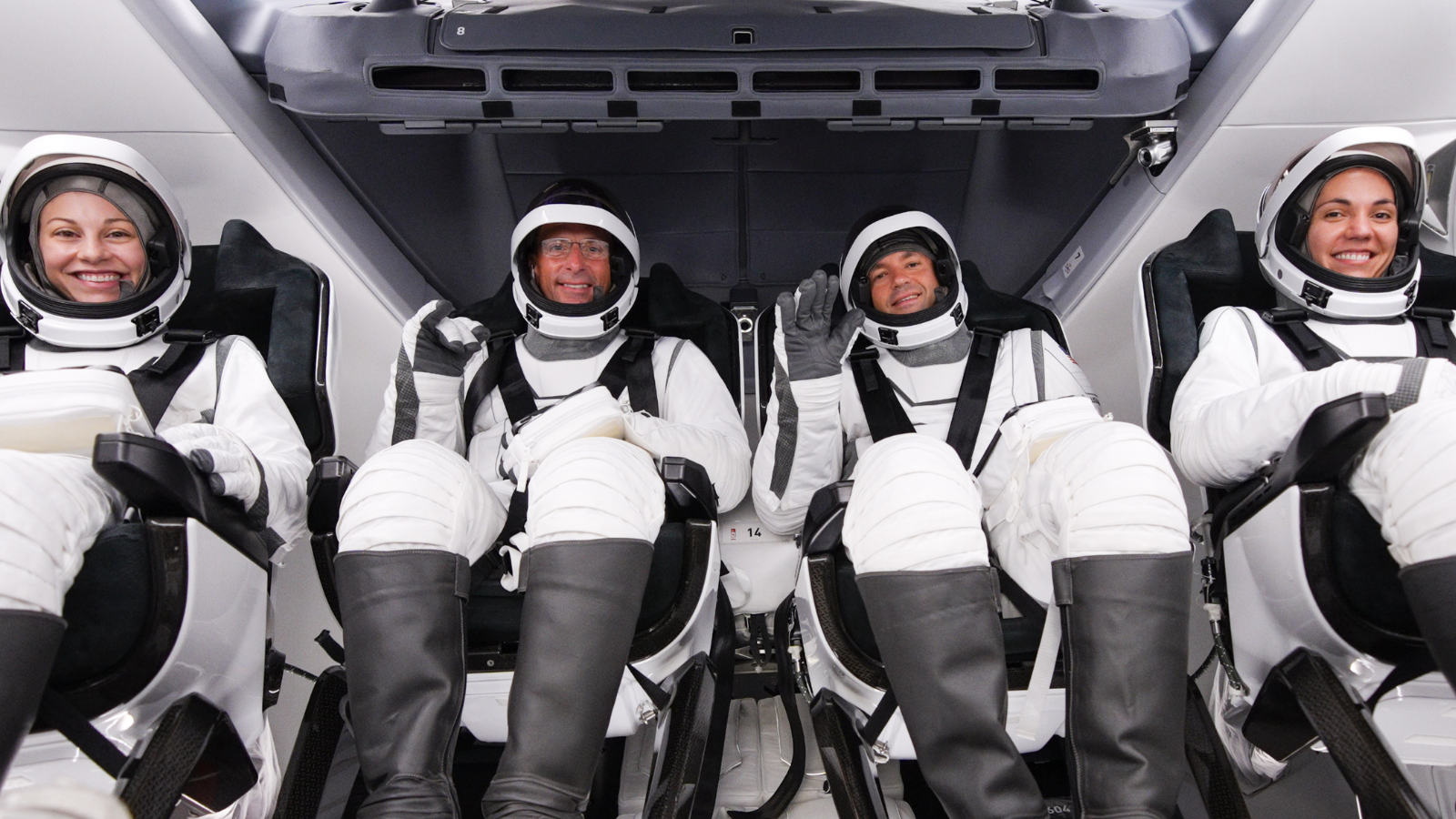
The spacewalk (also known as an extravehicular activity, or EVA), was made possible thanks to several specialized pieces of hardware developed for Polaris Dawn.
The crew wore new SpaceX-designed EVA suits that were made to be lightweight and flexible while still offering protection against the harsh, unforgiving environment in Earth's orbit. One SpaceX spacesuit engineer described it as "a suit of armor made of fabric."
One of Polaris Dawn's main goals was to test the suits, which SpaceX aims to use on a variety of future missions both in Earth's orbit and farther into space. "It's not lost on us that, you know, it might be 10 iterations from now and a bunch of evolutions of the suit, but that, someday, someone could be wearing a version of [it] that might be walking on Mars," Isaacman said on Aug. 26. "And it feels like, again, a huge honor to have that opportunity to test it out on this flight."
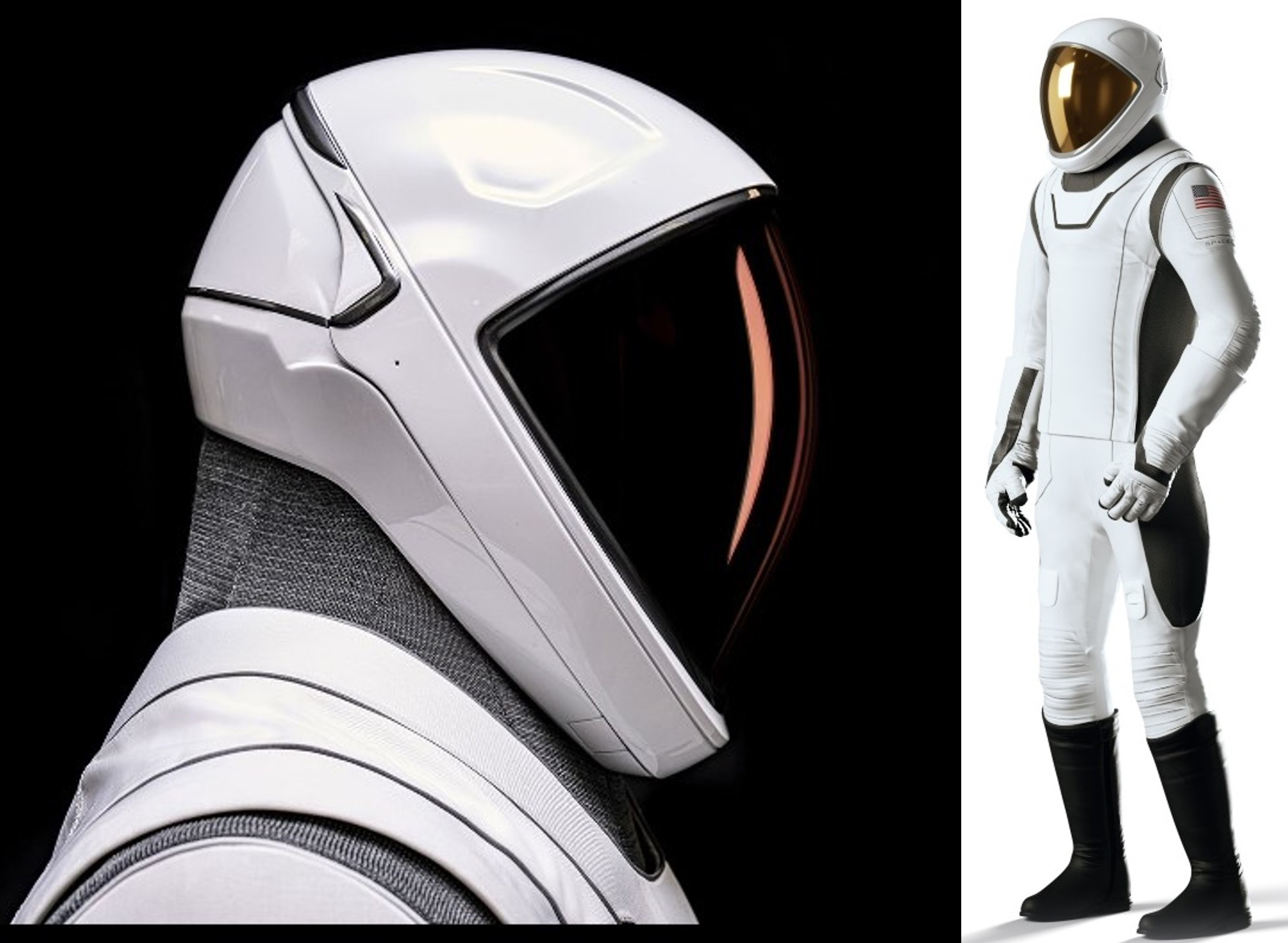
Polaris Dawn also features a heavily modified Crew Dragon spacecraft. The crew was able to exit the Resilience capsule to perform their spacewalk thanks to a specialized hatch designed just for the mission known as a "Skywalker," which replaced Dragon's typical ISS docking port.
The Skywalker hatch features a ladder and both handholds and footholds for the Polaris Dawn astronauts to grab onto as they maneuvered around the outside of the Dragon capsule.
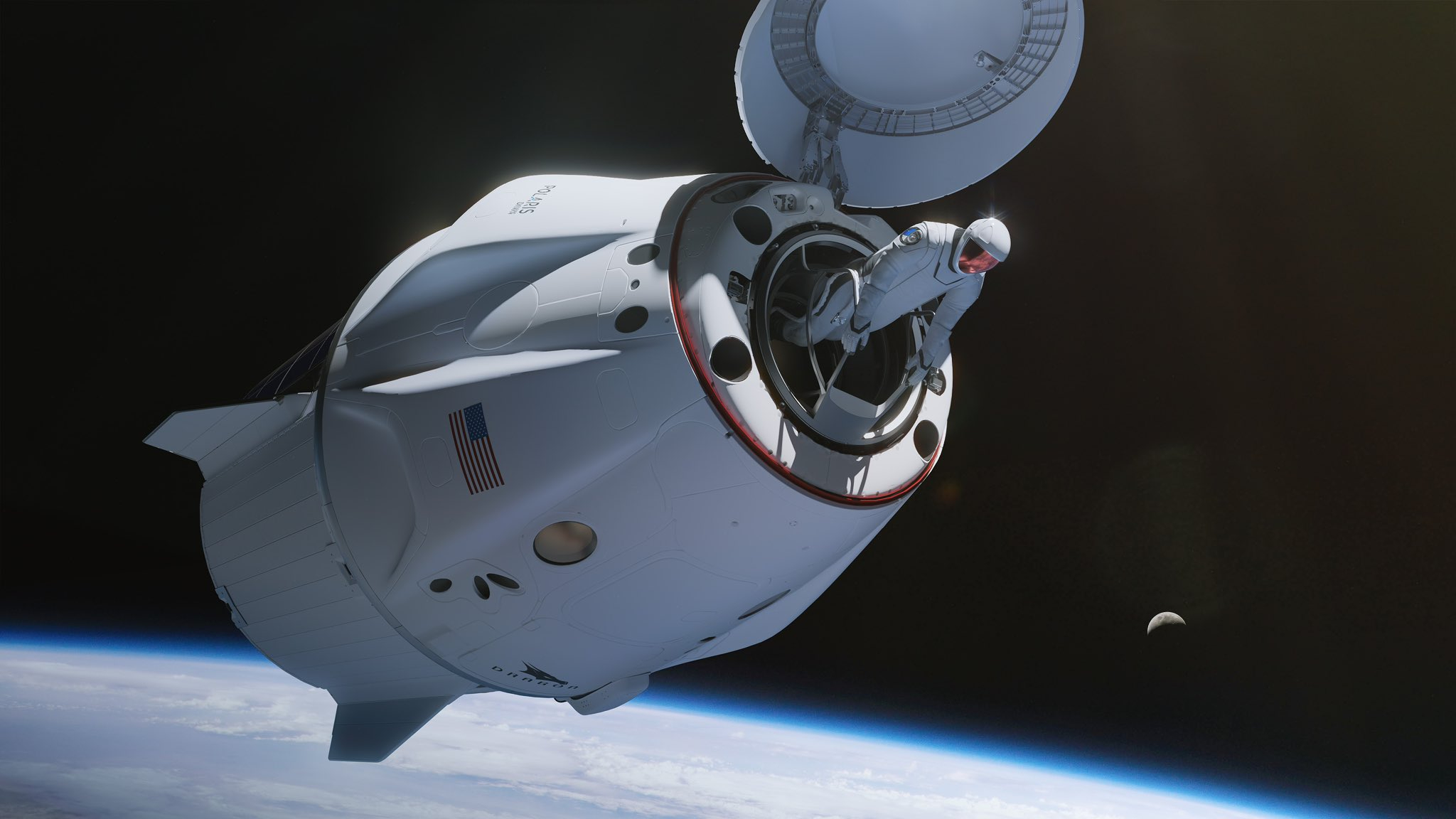
Polaris Dawn is also testing a new communication system that uses lasers to link up with SpaceX's Starlink satellites, a megaconstellation that provides broadband internet worldwide. The system "has the opportunity to open up an entirely new communication pathway, not just for Dragon, but for [...] Starships or other satellites or telescopes out there," Isaacman said at a press conference on Aug. 19.
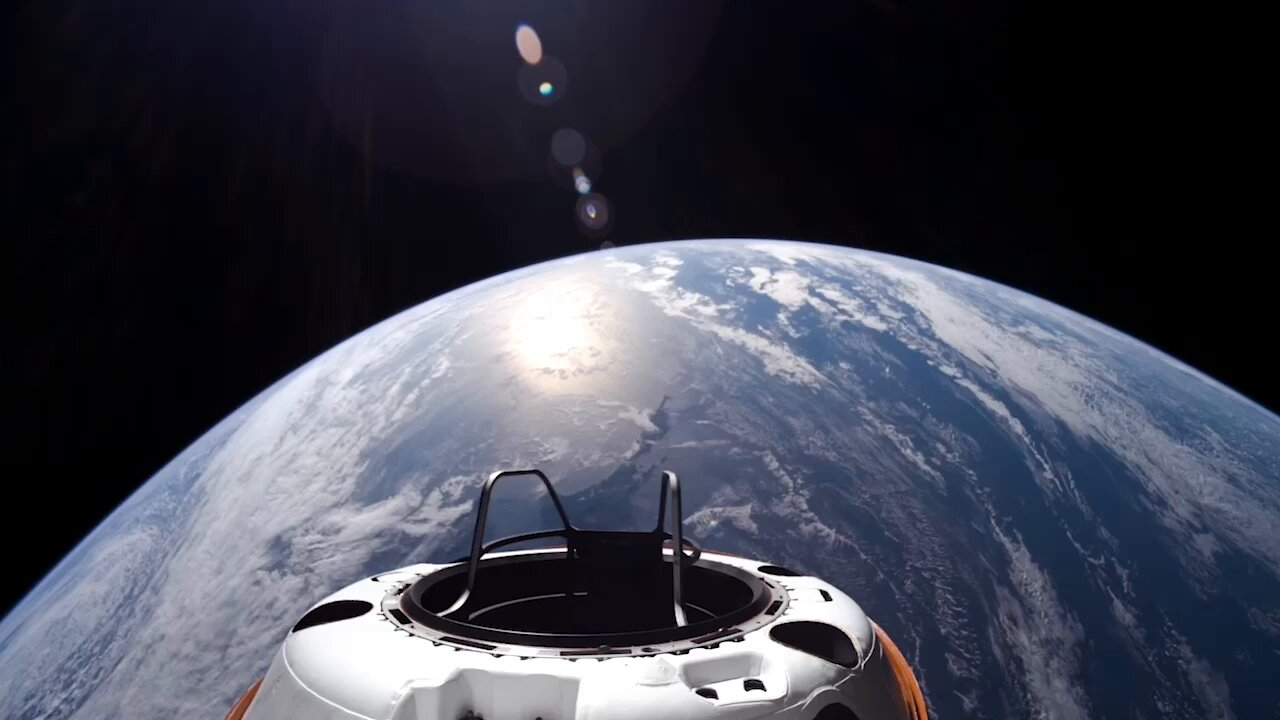
In addition to testing the new SpaceX hardware and spacesuits, the four Polaris Dawn astronauts have been conducting 36 different science experiments provided by 31 separate institutions. These experiments will be conducted throughout the mission, including some that will contribute data to NASA's Human Research Program, helping scientists better understand how the human body reacts to spaceflight.
Just like the spacesuit tests, these experiments are aimed at helping propel human exploration of the cosmos into the future. "Each mission, whether the crew is comprised of commercial or NASA astronauts, provides a key opportunity to expand our knowledge about how spaceflight affects human health," Jancy McPhee, associate chief scientist for human research at NASA, said in a statement. "Information gathered from Polaris Dawn will give us critical insights to help NASA plan for deeper space travel to the moon and Mars."
These experiments range from testing wearable devices that collect biometric data, attempts to mitigate motion sickness, and tests on eye health in microgravity. Polaris Dawn has also traveled through portions of Earth's Van Allen radiation belt, offering the opportunity to better understand how this radiation affects the human body.
Polaris Dawn is the second private SpaceX mission funded by Isaacman. The first, Inspiration4, launched in September 2021 and was the first crewed orbital mission to feature no professional astronauts. That mission also flew on Resilience.
Both Inspiration4 and Polaris Dawn raised funds for St. Jude Children's Research Hospital in Memphis, Tennessee. Inspiration 4 raised a total of $250 million for St. Jude.
Polaris Dawn is scheduled to return to Earth on its sixth day, splashing down under parachutes into one of several potential ocean landing zones off the coast of Florida. A recovery ship will then retrieve the Resilience spacecraft and crew, bringing to a close one of the most ambitious human spaceflight missions in decades.
Join our Space Forums to keep talking space on the latest missions, night sky and more! And if you have a news tip, correction or comment, let us know at: community@space.com.

Brett is curious about emerging aerospace technologies, alternative launch concepts, military space developments and uncrewed aircraft systems. Brett's work has appeared on Scientific American, The War Zone, Popular Science, the History Channel, Science Discovery and more. Brett has English degrees from Clemson University and the University of North Carolina at Charlotte. In his free time, Brett enjoys skywatching throughout the dark skies of the Appalachian mountains.
-
Mars Tafts So is it really a spacewalk if the astronaut just stands in the hatch? Just more a test of the suit. Reminds me of the Apollo 9 mission where the astronauts stood in the hatches of the command module and LEM.Reply -
Unclear Engineer Maybe not a "giant leap", but certainly more than a "baby step".Reply
I am interested in whether the seals on the hatch have resulted in any leakage since the hatch was reclosed. Those seals seemed to be a point of interest, if not concern, for both the crew and the engineers on the ground. -
controltestguy Ed White was a spacewalk. Alexei Leonov was a spacewalk. Standing in the open hatch moving your arms around is just testing the flexibility of the suit. PD not exactly in the Iron Man tradition. So why is the media calling it a spacewalk? Still, SpaceX is pushing the envelope, at least.Reply
-
Been There Is it "pioneering" if we did it 50 years ago? I do understand that it is news worthy, but maybe dial back the superlatives when the same thing has already been done with 1960's technology. I do believe they were sending back health telemetry back then as well. And does "Billionaire" need to be in the title? Why does that matter? I am being a bit "crusty" here, but 1) I watched it all happen as a kid already and 2) just finished the Apollo 13 documentary reminding me what non-billionaires and NASA engineers can do.Reply -
Unclear Engineer Well, it takes $billions to do it, no matter whether it is tax dollars taken from us non-billionaires or money spent by extremely wealthy people who got wealthy making profits off of products and services they provided to all of us non-billionaires.Reply
But, it does seem we get more progress per $billion from the billionaires than from the companies sponsored by tax $ .
